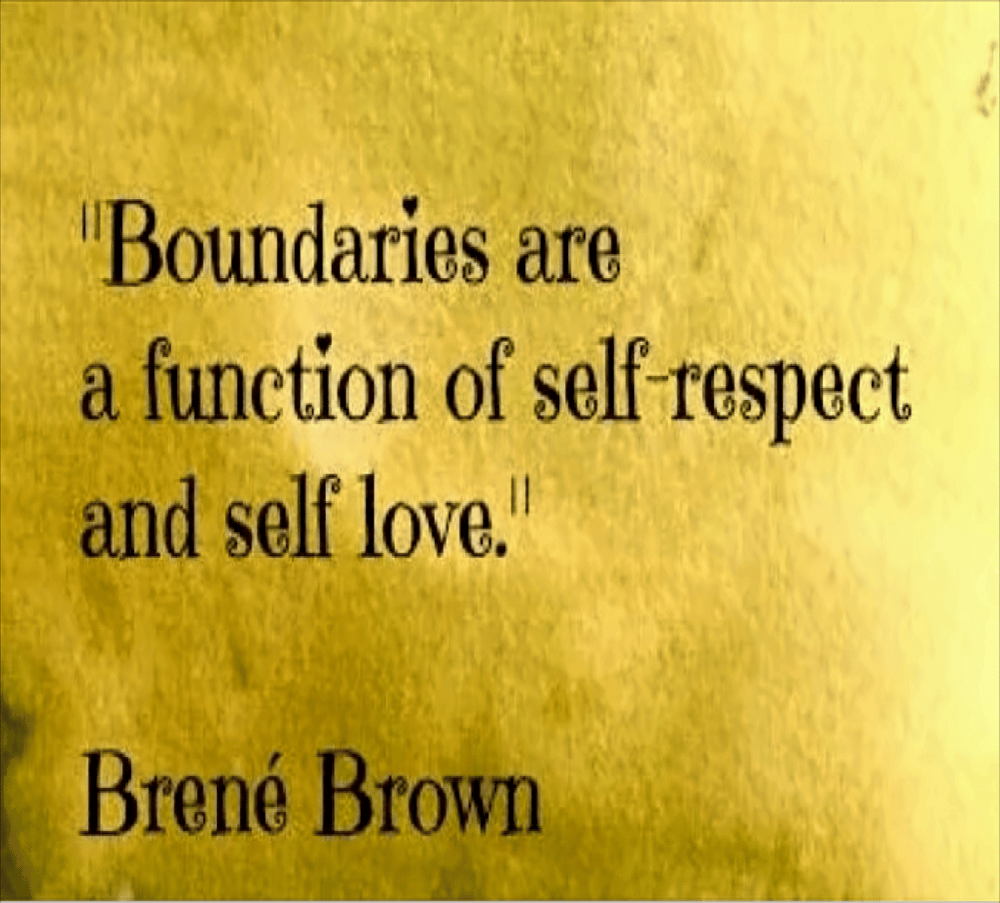“To practice the process of conflict resolution, we must completely abandon the goal of getting…
Creating Boundaries

Far, far away in a long-ago time, I made a wonderful discovery that I could say “No”. It was suddenly perfectly clear to me I could say “No” to things I didn’t want to commit to or do. That discovery brought such optimism around how to easily escape doing things which make me unhappy, frustrated or I simply don’t care about. And it opened so many possibilities for focusing on doing the things I wanted to do, that are rewarding, bringing joy and happiness to me.
It was sometime later that I connected my ability to say “No” to setting boundaries. That’s an important life lesson I continue to find that many people have missed, as it’s a lesson which can only be learned when ready to take full responsibility for oneself and what one does. Many times, we choose to interpret what we “do” as something that “happened to us”.
Responsibility is one of my top 10 strengths (CliftonStrengths profile) and the core of that strength is that when I say “Yes” to anything, I assume psychological commitment for whatever I agreed to.
As a strength, responsibility helps me gain trust; keep going when something is difficult; and even builds the foundation for how I uniquely build credibility and influence – through producing what I said I would deliver.
Where it can get me sideways is when I become frustrated after saying “Yes” to something I never wanted to start, which I committed to finish. It can also get me sideways when I say “Yes” to a specific task or start a new relationship where others will not engage and contribute their part. Then I assume the responsibility of doing everything for everyone.
This is typically referred to as “Enabling Behavior”. I have invested a lot of time learning how to manage and balance my responsibility strength to avoid the frustration of committing to something I wish I hadn’t and/or stop assuming responsibility for someone else and enabling them to avoid their part.
One of the best ways to manage for both scenarios is to set boundaries – and the easiest boundary to set is simply saying “No”.
Of course, this applies to any situation where we have full autonomy to opt out. There may be fewer things to simply say “No” to in the workplace, where it is typically right to say “Yes”. That’s the job.
Even in the workplace when asked to do something which goes against personal values, morals or beliefs, we have the option to set a boundary and say “No”, though our career trajectory could be altered by standing strong for what matters to us.
Regardless of the situation, it is always our option to say “No” to something we will not participate in. When we are responsible for what we do, we exercise our choice for our reasons every time. This is the essence of setting boundaries.
Of course, there are many boundaries aside from simply saying “No” which we can set and exercise in our life. The key thing to remember is:
When you set a boundary, it belongs to You… you are setting it for you, vs. against someone else.
Creating Boundaries
There are three Big Lessons I focus on when working with others to create boundaries:
• It’s important to remember that You are the only person who is with you your entire life.
Therefore, no one knows more about what you want or need or will take better care of you than you do. If something is important to you, you are the best one to ask for what you want or need and set boundaries to protect yourself and/or promote what matters to you. If you are not willing to do that, you can’t expect that someone else will make it a priority, either.
Waiting for someone to notice your needs and figure out how to best meet them is going to be inconsistent and disappointing in many ways.
Taking responsibility for yourself and what you need is a much more effective way to get what you want.
• When you define and set a boundary – it belongs to You.
Your boundaries are for You, not against someone else. This is an important distinction. We often feel others need to agree and comply with our boundaries and that is not the case. No one has to agree, and some will not comply. That is when enforcing one’s boundary becomes paramount. We need to be able to implement and comply with our own boundary and hold the line.
An important component is to be sure we can consistently enforce our own boundary. It needs to be clearly communicated and easily executed … something within our scope of control.
Example: I am uncomfortable when you raise your voice and say awful things to me when we are talking about sensitive topics. I have to set a new boundary: when you begin to raise your voice and/or say disrespectful things, I will ask you to stop. If you don’t, I will leave the conversation and not re-engage in the discussion without a facilitator or guide to help us navigate the conversation. You are welcome to help select the facilitator/guide, though proceeding without a facilitator/guide will be non-negotiable.
In this example, if we leave the conversation when the other party becomes disrespectful and begins to raise their voice. We simply need to hold the line and not re-engage on the topic (even in text or non-verbal conversation) without a facilitator/guide. That is the core of the boundary.
And the boundary was set for our behavior, which is all we can control. Regardless of their behavior, we can manage our response until they are ready to re-engage in the way we requested. Enforcing our boundary is about controlling our behavior and what we will engage in – never about controlling them.
This is where our commitment to consistently enforce our boundary becomes a deal breaker. To enforce our boundary, we must be willing to manage our own behavior and consistently do what we said we will do. Too many times I witness people giving their boundary ownership to someone else or completely
giving up on enforcing their boundaries because they focus only on the other person’s behavior vs.
simply managing their own (“well, when they did this, I had to do that”).
The truth is, it’s not that complicated, if we remember Big Lesson #1 – No One will take better care of me than I do. Part of taking care of ourselves is to manage our behavior and be true to what we commit to.
When our boundaries allow us to do that, ours is the only compliance that matters.
• We all need boundaries in every situation. Boundaries are not simply to protect us in complicated, dysfunctional relationships or situations. They are potentially especially important to guide us in healthy relationships.
Creating boundaries is a way for one to clarify what is important to oneself and ensure what we need or want.
And yes, this is critical in situations or relationships where we are disrespected, undervalued, and underappreciated. In those cases, we need to know our boundaries well in advance so we can simply execute them in the moment, if needed. And in these cases, we may not even need to communicate the boundary out loud or in advance. Implementing the boundary may be the most important thing.
We need to remember others will treat us how they want to. It is our responsibility to ensure we are treated how we want to be treated and be prepared to remove ourselves from an environment where that is not happening.
However, with those who love and care about us, value who we are, and want to help meet our needs, sharing boundaries is a key factor in navigating a healthy relationship with clear expectations and strong agreements. Clear information about our boundaries is important for those we spend the most time with.
Too often, I see people make the mistake of believing that those who spend a lot of time with us or care most about us should “already know” or simply “figure out” what we want and how to meet our needs or avoid our hot spots. And it could be possible to have those practically perfect people in our lives who do have that magic intuition. If so, treasure and appreciate their rare and wonderful insight and empathy.
Throughout our lives, most of us grow, learn, and change our minds, needs, wants and the ways we contribute. Our boundaries shift as we grow and develop and the more we factor in and share this new, relevant input with those who are part of our life journey, the more balanced our relationships will be.
Re-evaluating, renewing, and communicating our boundaries is a useful part of that balance. Especially when we embrace that our boundaries are necessary, helpful, belong to us, and are for us, vs. against someone.
How and When to Communicate Boundaries
Something important to remember is that boundaries do more than protect – they are a strong, proactive support to drama-free, stable confidence and trust in personal and professional relationships. The important thing is to be clear about what they are (ours and other’s) and why they matter.
And to be successful, we need to do more than set them. We need to implement and enforce them. And the first step to implementing our boundaries is to proactively communicate them with others, with honest intent and at the right time, to eliminate surprise for anyone.
There are several steps to follow to ensure boundaries are heard and agreed to. Three things to consider when communicating boundaries:
• Whenever possible, communicate the boundary before it is needed, away from any “moment of crisis”.
This is especially healthy for our closest relationships. The more sensitive the topic or situation, the more important it is to discuss it and the agree on the boundary before it’s needed. Waiting until a boundary is needed can feel like a surprise, or that we are changing expectations without notice. It will feel better if we have discussed and agreed to it in advance. Then we can bring it forward when needed and remember our agreement to implement it – without resentment.
• Communicate the boundary from the perspective of this is For Me, not Against You.
Even if there is no conflict or specific issue in flight, it may feel like an attack to someone else when we want to talk about a boundary. A key to success will be to present it from the perspective of “what I learned or discovered I need” vs. “how to fix / stop what you do/did wrong”.
When we ask for what we need, or for someone’s help in setting a boundary, they are more likely to listen, participate in the discussion and respond favorably.
• Communicate with openness and time for the other party to say what they think and/or ask whether they need anything in relation to this specific boundary (stay focused on this topic. New topics / boundaries can be introduced in a new discussion).
When we ask how we can help, or if there is something the other(s) need(s), we create opportunity for a healthy two-way dialog which will more likely ensure agreement of all parties.
Boundaries are one of the best self-care tools we must practice, to be responsible for what we do and be secure in navigating all situations vs. letting things happen to us. I believe in our capacity to confidently listen to our own voice and define the things we need, in ways that will help others know how to partner with us and thrive in the life we want for ourselves.
Like everything – setting and enforcing boundaries is a practice. There will be days we do well and other days we may struggle. Still, the more we intentionally focus on and practice the self-care and personal responsibility of setting and enforcing our boundaries, the more consistent we will be. It’s worth the effort to prepare and practice – and it’s rewarding to watch the positive results in our relationships.
When we are secure in our boundaries, we can be open to all interactions with confidence and trust.
And we can begin that TODAY!
Written by Becky June, January 2023

